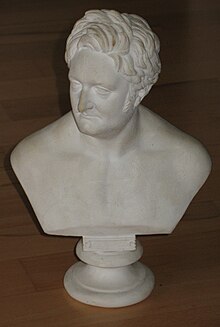Heinrich Meyer (physician)

Johann Carl Heinrich Meyer (born January 2, 1767 in Stettin ; † August 6, 1828 in Berlin , Kochstrasse 21) was a German physician.
Life
Heinrich Meyer was born in Stettin as the son of the local pharmacist and chemist Johann Carl Friedrich Meyer and Maria Susanne Beurer, who came from an old Nuremberg pharmacist family. After attending school in Szczecin and training as a pharmacist in his father's court and garrison pharmacy in Szczecin Palace , he first worked as an assistant in pharmacies in Frankfurt am Main from 1787 and in Strasbourg from 1789 , where he started the French Revolution experienced before he moved to Morges on Lake Geneva . From 1792 to 1793 he studied pharmacy at the University of Erlangen and then until 1794 in Berlin, where he attended an anatomical course at the Collegium medico-chirurgicum . Then he returned to Szczecin. In October of the same year he went back to Berlin, where he studied medicine until 1796. He then moved to the University of Halle under his later friend, Johann Christian Reil , where he received his doctorate in general medicine in 1797 . Afterwards he did a practical year in the then famous clinical institutions in Vienna , went back to Berlin in April 1798 and settled there as a doctor.
From 1801 Meyer held public lectures on physiology in Berlin to an auditorium of doctors and scholars, including Friedrich Nicolai . In 1805 he published the "Outline of the Physiology of the Human Body".
With Ernst Ludwig Heim , the initiator, Meyer was a strong supporter of the smallpox vaccination in Berlin, which Meyer promoted through free vaccinations.
His practice was wanted, his circle of friends and patients included: Achim von Arnim , Johann Gottlieb Fichte , ETA Hoffmann , Friedrich Schleiermacher , Ernst Ludwig Heim , Friedrich Gedike , Georg Wilhelm Friedrich Hegel , Karl Wilhelm Ferdinand Solger , Franz Joseph Gall , Friedrich Wilhelm Joseph Schelling , Johann Christian Reil , Olfers-Staegemann-Kreis, August Wilhelm Iffland , Johann Goercke , Christoph Wilhelm Hufeland , Jean Henri Samuel Formey , Johann Gottfried Herder , Gebhard Leberecht von Blücher , August Neidhardt von Gneisenau and others. Meyer met Johann Wolfgang von Goethe personally in Heidelberg in 1815 .
The Berlin sculptor Karl Wichmann (Carl Friedrich W.) made a bust of Meyer in Berlin in 1806, during Meyer's lifetime, which was later made in plaster by Leonhard Posch . Furthermore, portrait medals in iron art by Heinrich and Sophie Meyer come from Posch, copies of which have been preserved in the Coin Cabinet of the Staatliche Museen zu Berlin .
Meyer married Sophie Gottliebe Gedike, daughter of Friedrich Gedike , the pioneer of the Prussian education and school reform , on November 29, 1806, in the Friedrichswerder Church in Berlin-Mitte . From this marriage come the ennobled son Leuthold and the daughter Adelgunde, who married into the Prussian nobility.
Fonts
- Outline of the physiology of the human body for the purpose of his lectures designed by Dr. Johann Carl Heinrich Meyer, practicing doctor in Berlin , Berlin 1805, publisher: In der Realschulbuchhandlung
literature
- Heinrich Meyer . In: New Nekrolog der Deutschen. 6th year 1828, 2nd part, Bernhard Friedrich Voigt, Ilmenau 1830, pp. 602–607.
- Article Meyer, Heinrich. In: German Biographical Encyclopedia .
- Hirsch: Doctors. Biographical lexicon of the outstanding doctors of all times and peoples. Berlin 1929–1935 (2nd edition).
Individual evidence
- ^ Vossische Zeitung 1828 No. 189
- ^ Georg Wilhelm Kessler : The old home. Brockhaus, Leipzig 1846, p. 3ff.
- ^ Royal Academy of the Arts Berlin : The catalogs of the Berlin Academy exhibitions 1786-1850. Vol. 1, p. 272.
- ↑ Anne Forschler-Tarrasch: Leonhard Posch . Verlag Willmuth Arenhövel, Berlin 2002, p. 25, p. 122 ff, p. 238.
| personal data | |
|---|---|
| SURNAME | Meyer, Heinrich |
| ALTERNATIVE NAMES | Meyer, Johann Carl Heinrich (full name) |
| BRIEF DESCRIPTION | German medic |
| DATE OF BIRTH | January 2, 1767 |
| PLACE OF BIRTH | Szczecin |
| DATE OF DEATH | August 6, 1828 |
| Place of death | Berlin |